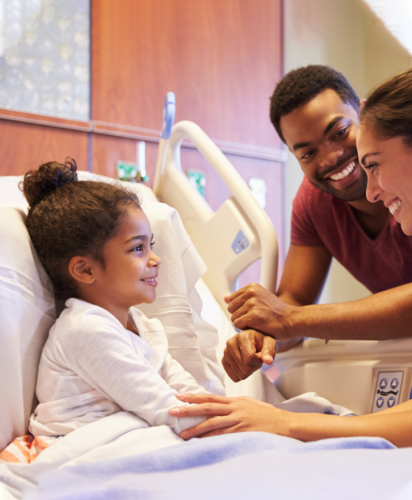
Summary
Imaging tests can be frightening for children, resulting in many paediatric patients requiring sedation for these procedures. GE Healthcare introduced the Adventure Series™ to tackle this problem. Scanning rooms and machines were painted in various ‘adventure themes’, such as pirate ships or spaceships. These child-friendly scanners resulted in fewer patients needing sedation, greater throughput for imaging services and higher patient satisfaction.1 2
Challenge
Imaging tests, such as magnetic resonance imaging (MRI) and computed tomography (CT) scans, can be frightening for children. At the University of Pittsburgh Medical Centre (UPMC) children’s hospital, most children needing an MRI or CT scan had to be sedated for the procedure.1 When an anaesthesiologist was not available, tests were often rescheduled – wasting hospital resources and causing additional anxiety for the child and their family.2
Solution
GE Healthcare introduced the Adventure Series™ – a creative solution to make the imaging experience less intimidating. Imaging machines and their rooms were painted in exciting ‘adventure themes’ such as pirate ships or spaceships. Hospital staff were given scripts to guide patients through their imaging ‘adventure’, and the noises generated by the imaging machines were weaved into the adventure itself (e.g. the sound of the MRI scanner became the noise of a rocket ship).3
The pilot project for the Adventure Series™ MRI machines took place in the UPMC children’s hospital. It has since been adopted by other hospitals such as the University of California San Francisco (UCSF) Medical Centre, the Children’s National and the Lurie Children’s Hospital of Chicago.4 The Adventure Series™ is available for MRIs, CT scans, positron emission tomography (PET) scans and nuclear imaging.3
What has it achieved?
Results following the introduction of the Adventure Series™ MRI machine at the UPMC children’s hospital were:
• Overall patient satisfaction increased by 90%
• Fewer than 27% of children needed sedation for MRI scans – previously, the hospital had to sedate almost every child under the age of 9 before an MRI scan
• More patients were scanned each day.1 2
Further information
• A paper describing innovation in paediatric technology, with further details on the Adventure Series™
• The Adventure Series™ brochure by GE Healthcare
• The Adventure Series™ websites for MRI, CT, PET-CT and nuclear medicine
• The Adventure Series™ in action at the UPMC children’s hospital
References:
- Boulton G. 2016. By turning medical scans into adventures, GE eases children's fears. Available here: http://archive.jsonline.com/business/by-turning-medical-scans-into-adventures-ge-eases-childrens-fears-b99647870z1-366161191.html/ [accessed: March 2019]
- Kelley T, Kelley D. 2013. Kids were terrified of getting MRIs. Then one man figured out a better way. Available here: https://slate.com/human-interest/2013/10/creative-confidence-a-new-book-from-ideo-s-tom-and-david-kelley.html [accessed: April 2019]
- GE Healthcare. 2011. GE Adventure Series: imaging that puts children first. Waukesha: General Electric Company
- Stern G. 2018. Thinking Big for the Smallest Patients: Innovation in Pediatric Technology. Biomedical Instrumentation & Technology 52(4): 260-70